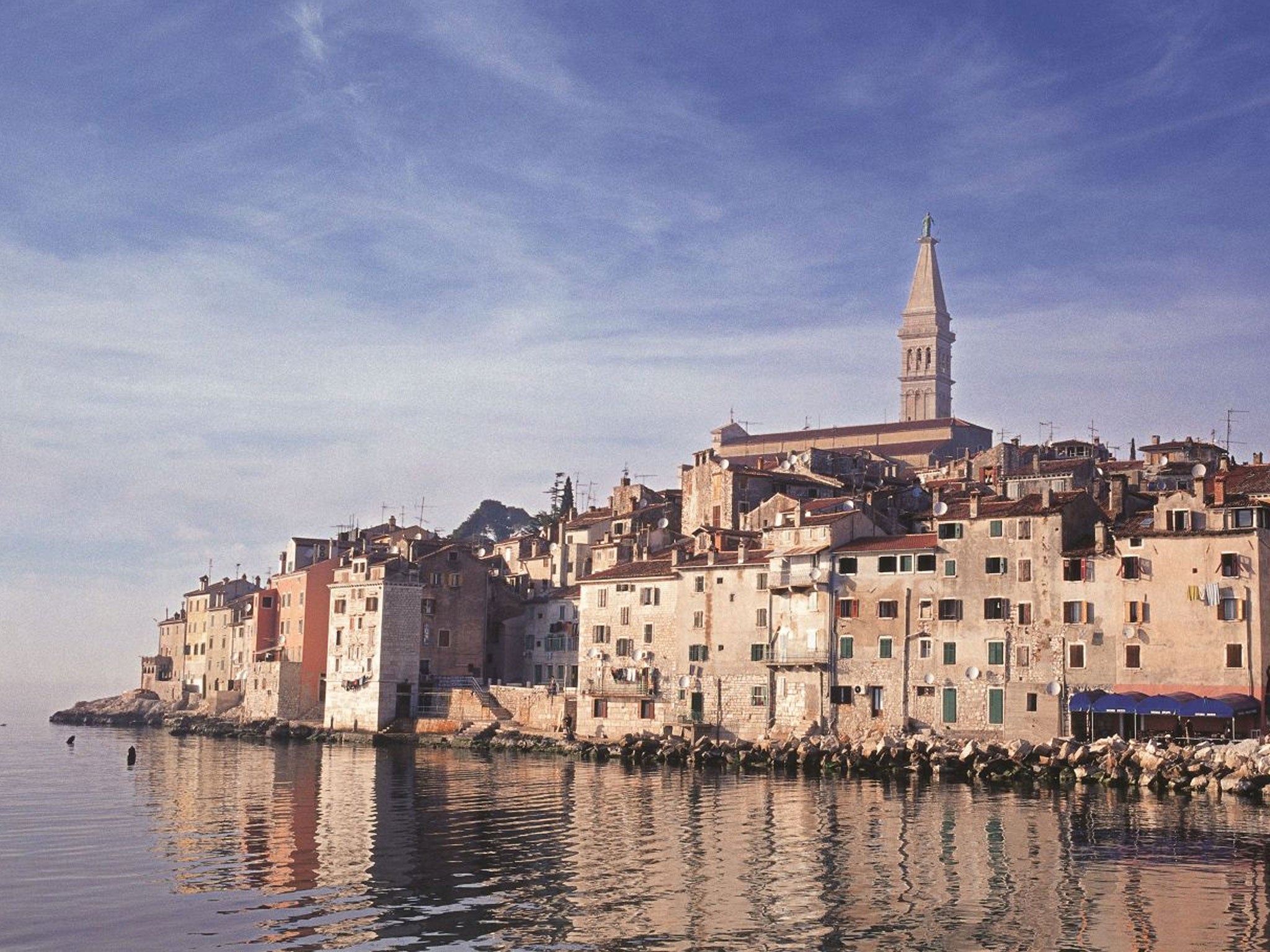Rovinj: An artists' colony on the Adriatic
Painters and poets have long flocked to the Croatian city. James Hopkin pays a visit to learn its secrets

It was a wet and windy evening on Naked Hill. The heavy rain was lashing at the windows of Tomislav Brajnovic's white stone studio. We sat at a table beside an open fire, eating squid caught locally by the artist himself, with rocket salad dowsed in Istrian olive oil, washed down with red wine from his own vineyard. On the walls of the studio hung Tomislav's works – he was once a student at Central Saint Martins – which appropriate old pictures and books with slogans such as "Allow me to be tolerant but to disagree" and often challenge what he considers to be "unethical art" to reveal a political context. One of his installations included putting a sign saying "Theatre of Crime" outside the amphitheatre in Pula.
Naked Hill – Golo Brdo in Croatian – is in Rovinjsko Selo, a small town about four miles from the exquisite 14th-century city of Rovinj on the west coast of the Istrian pensinsula. Tomislav's studio sits beside the family home, a curious hybrid of church, fortress and house. Across the way, his father, Marcelo, 79, also an artist, has just built himself "a mini-factory", where he will produce packets of communion wine and wafers to be sold in supermarkets. "Why should the church have the monopoly?" is his motivation. Marcelo's art has always been provocative, even during the days of the former Yugoslavia.
Marcelo Brajnovic first came to Rovinj in the late 1940s following the Italian exodus after the war. The Italians left a sleepy, desolate city of winding stone alleys, 14th-century churches, empty Venetian townhouses and the cathedral of Saint Euphemia – all beside the glistening Adriatic, with Venice just across the water. It was the perfect place to set up an artists' colony. Painter Bruno Mascarelli, who still lives in the town, was one of the first to arrive. Marcelo Brajnovic, as one of his students, came too. Other painters and poets followed from Zagreb and Belgrade to form one of the first colonies of its kind in Europe. As one of the arrivals recorded, "Rovinj offered the tranquillity of an abandoned city, space for work and abundant solitude".
In early summer, and again from September onwards, Rovinj and its archipelago of 21 islands is relatively free of tourists. You can wander undisturbed among the cluster of ateliers and galleries offering paintings, ceramics and locally made arts and crafts. You have to rely on serendipity to find the best work, but that's part of the pleasure.
Along the riva harbour front, there are cafés, bars and designated photography sites from which you can view the wooden fishing vessels, including the city's traditional Batana boat, and the nearest islands of St Catherine and Red in the distance. The latter hosts a 3rd-century monastery that was taken over by the Austro-Hungarians as a hotel and restaurant. Their furnishings remain, making another painterly scene. It's an atmospheric, even eerie, place to visit especially when complemented with a quick walk up to the island's mausoleum. Then there's the red-tiled old town itself, huddled into a peninsula across the bay and rising to the Venetian belfry at its summit.
Viewed from the sea, the crumbling pastel facades of the old town are endlessly enchanting because they are transformed by every single change of light. In the summer, the occasional white cloud does not blemish the blue sky, but merely serves as decoration. It is indeed a painter's dream, as British artist Jan Ejsymontt found out when she first visited Rovinj. She subsequently moved there to open her Atelier Sottomuro. Her business is thriving now and she also runs creative workshops.
Back in 1967, the original members of the artists' colony set up a one-day open-air exhibition called Grisia, along the steep, stone alley of that name. The annual show even continued through the war of 1991-95. Nowadays that street has been largely taken over by shops selling tourist souvenirs to the hordes that visit in peak season. The Grisia exhibition is still running, but seems to reflect, a little more each year, the contemporary desire for kitsch.
Clearly, with Croatia's EU accession in July this year increasing tourism further, the various powers of Rovinj – the local government, and the tobacco-factory magnate whose company also owns some of the hotels – must work together to preserve both the town's cultural heritage, along with the spirit and independence of the original artists' colony. Perhaps with this in mind, Rovinj already offers an art exchange exhibition, an ethno film festival, an avant-garde jazz festival, as well as a group called Creative Guidepost that promotes "educational tourism", teaching young visitors the history and mythology of the area through art.
On the plane back, I sat next to an elderly painter from the Lake District who had just spent two weeks alone in Rovinj working on a series of watercolours. What did he make of the place? "Absolutely beautiful!" he said, his eyes still sparkling with the reflected Adriatic. "What's more," he added, "every morning the owner of a café brought a coffee to my easel on the harbour. And on the final day he bought one of my pictures. For 430 kuna! How much is that in quid?"
Travel essentials
Getting there
James Hopkin flew with Jet2 (0871 226 1737; jet2.com) from Manchester to Pula. From there, it is a 40-minute bus journey to Rovinj. The airline also flies from Glasgow, while Ryanair (0871 246 0000; ryanair.com) offers an alternative from Stansted.
Staying there
He was a guest of Hotel Lone in Rovinj (00 385 52 800 250; lonehotel.com), where doubles start at €102 (£86), including breakfast.
More information
Croatian Tourism Board: croatia.hr
Join our commenting forum
Join thought-provoking conversations, follow other Independent readers and see their replies
Comments